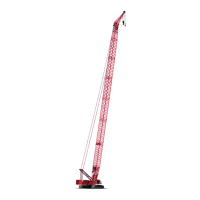INTRODUCTION 16000 SERVICE/MAINTENANCE MANUAL
1-44
Published 05-03-17, Control # 228-03
ACCESSORY SYSTEM COMPONENTS
Accessory Systems
Accessory system components include the rotating bed
jacking cylinders, mast raising cylinders (high pressure),
rigging winch, rotating bed pins, boom hinge pins, cab tilt,
counterweight pins, crawler pin cylinders (low pressure), and
the engine cooling fan.
The accessory/MAX-ER pump is the hydraulic pressure
source to operate the accessory system components. The
accessory system proportional relief valve is controlled by
the Node-3 controller. The accessory system and the lower
accessory system is monitored by separate pressure
senders. During stand-by, the relief valve is set at
approximately 28 bar (406 psi). Excess supply flow from the
accessory/MAX-ER pump is dumped through the valve to
the tank. When an accessory system component is enabled,
an input signal is sent to the Node-1 controller. The Node-3
controller sends a variable 0 to 24 volt signal to the
accessory system proportional relief solenoid HS-68 to
increase the relief valve setting up to 207 bar (3,003 psi).
The accessory systems pressure increases to operate the
selected component.
Jacking Cylinders
See Figure 1-29 and Figure 1-30.
Telescopic type jacking cylinders are mounted on each
corner of the rotating bed. The jacking cylinder operation is
controlled with switches on the hand-held wireless remote
and programming. Operation of all four jacking cylinders is
the same. The following description of operation is for the
right front jacking cylinder.
The rotating bed level sensor keeps the rotating bed level
when the ALL switch is used. The sensor controls the fluid to
each cylinder by opening/closing the proportional control
valves.
Each jacking cylinder has counterbalance valves at the
cylinder ports. The counterbalance valves ensure smooth
control when raising or lowering the crane on the jacks. The
counterbalance valves lock the jacking cylinders in place if
there is a hydraulic line breakage or accidental operation of
the control valve when the crane's power is shut down. Also,
the counterbalance valves provide relief protection for the
cylinders and shields them from mechanical overloading.
When a jacking cylinder proportional control valve is not
enabled, it shifts to the neutral position where both the valve
section cylinder ports are connected to the tank. This
prevents in-line pressure from opening the counterbalance
valve, holding the rotating bed load in position by the
counterbalance valve.
Rotating Bed Jacking - Raise
Move the jacking switch to the extend position and hold
(front right jack is shown in Figure 1-29
). An input voltage is
sent to the Node-1 controller. The Node-4 controller sends a
24 volt output to enable the selected jacking cylinder
proportional control solenoid HS-62 and shifts the valve to
the extend position. The Node-3 controller sends a variable
zero to 24 volt output to enable the accessory system
proportional relief solenoid HS-68.
Hydraulic fluid pressure at approximately 204 bar (2,959 psi)
flows to the selected jacking cylinder(s) proportional control
valve. Hydraulic fluid exits the valve and enters the free-flow
check valve section of the jacking cylinder counterbalance
valve. Hydraulic fluid then enters the piston end of the
jacking cylinder, extending the cylinder to raise the rotating
bed. The Node-4 controller monitors the accessory system
pressure sender to control the jacking cylinder raising speed
rate.
Hydraulic fluid returning to the tank from the rod end of the
jacking cylinder is blocked by the free-flow check valve
section of the counterbalance valve and flows through the
flow restraining section that has a relief setting of 172 bar
(2,495 psi). The counterbalance valve acts as a deceleration
control and functions with a 3:1 pilot ratio of the relief
pressure. This permits the valve to open when the pressure
in rod end of the cylinder is approximately 57 bar (827 psi).
The restraining section of the counterbalance valve opens,
controlling the fluid out of the jacking cylinder. Hydraulic fluid
then flows through the free-flow check valve section of the
WARNING
Collapsing Hazard!
Keep the rotating bed as level as possible while jacking.
Operating the jacking cylinder with the rotating bed more
than three degrees out of level can cause structural
damage to jacking cylinders and possible collapse of the
rotating bed.
FIGURE 1-29
HS-63
HS-61
Left
Front
Pressure
Sender
HS-60
Accessory
Pump
Crane Level
Sensor
Hand-Held
Wireless Remote
Right
Front
Left
Rear
Right
Rear
HS-64
HS-65
HS-66
HS-67
HS-68
HS-62
35 to 204 bar
500 to 3,00 psi
16-1024

